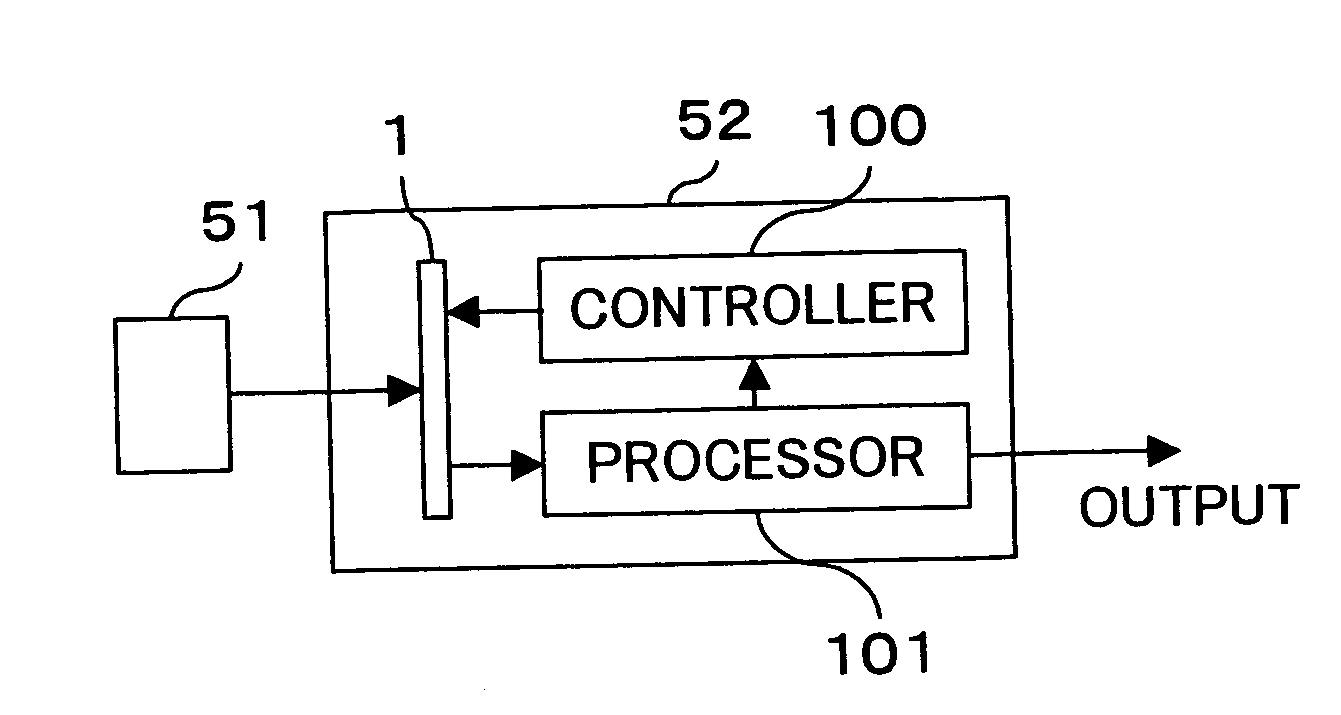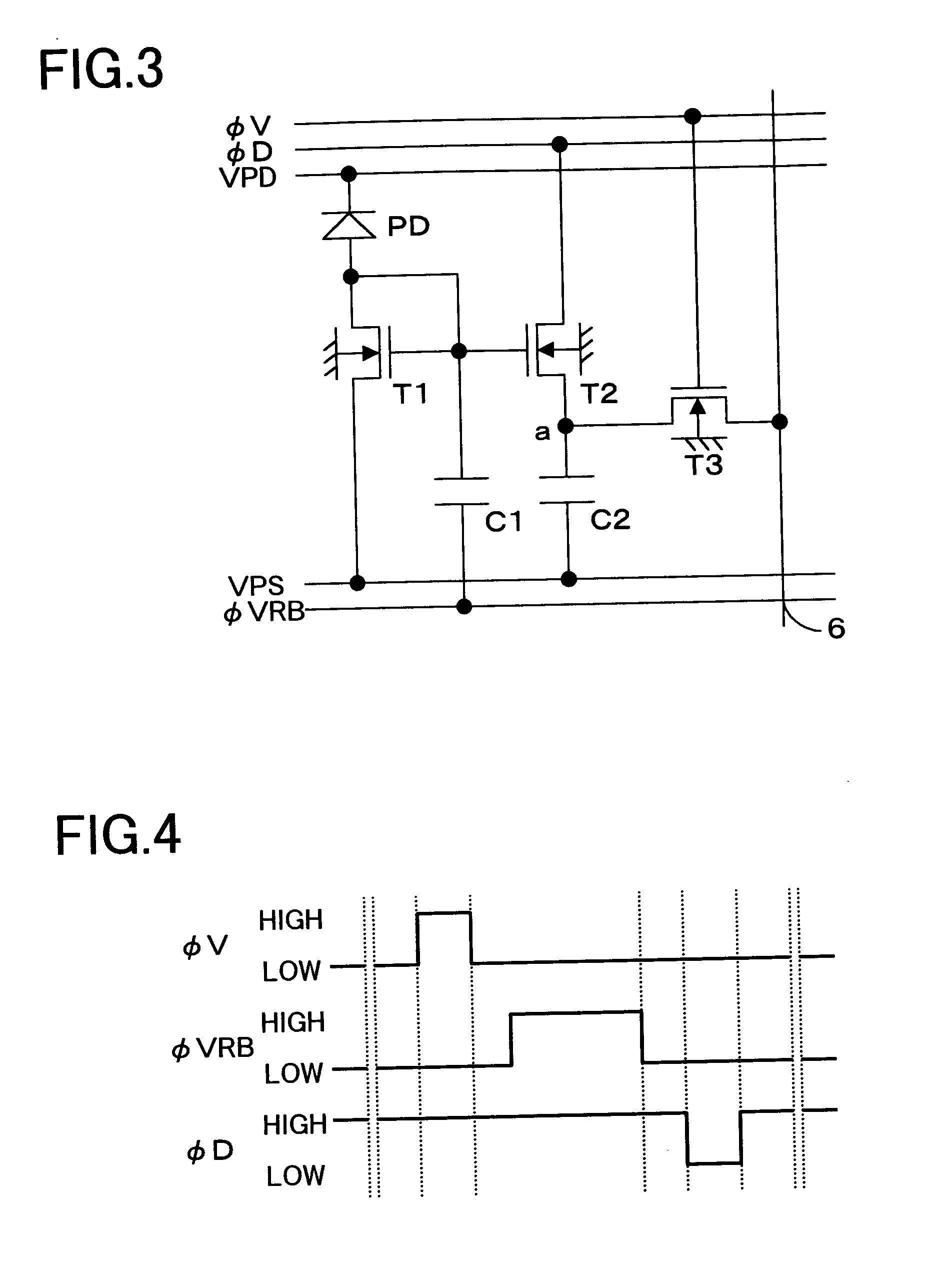Solid-state logarithmic image sensing device
a logarithmic image and sensing device technology, applied in the field of solid-state logarithmic image sensing devices, can solve the problems of narrow dynamic range, requiring accurate control of exposure amount, and disadvantage of comparatively narrow dynamic range, and achieve the effect of high resolution and quick respons
- Summary
- Abstract
- Description
- Claims
- Application Information
AI Technical Summary
Benefits of technology
Problems solved by technology
Method used
Image
Examples
first embodiment
[0057] Now, a first embodiment (FIG. 3) of the invention, which is applicable to each pixel of the first example of the pixel configuration shown in FIG. 2, will be described with reference to the drawings.
[0058] In FIG. 3, a pn photodiode PD serves as a photosensitive element (photoelectric conversion portion). The anode of this photodiode PD is connected to the gate and drain of a first MOS transistor T1, and also to the gate of a second MOS transistor T2. The source of the MOS transistor T2 is connected to the drain of a third MOS transistor T3 for selecting a row. The source of this MOS transistor T3 is connected to the output signal line 6 (this output signal line 6 corresponds to the output signal lines 6-1, 6-2, . . . , 6-m in FIG. 2). The MOS transistors T1 to T3 are all N-channel MOS transistors, and have their back gates grounded.
[0059] A direct-current voltage VPD is applied to the cathode of the photodiode PD. On the other hand, a direct-current voltage VPS is applied ...
second embodiment
[0070] Next, a second embodiment of the invention will be described with reference to the drawings. FIG. 6 is a circuit diagram showing the configuration of each pixel of the solid-state image-sensing device of this embodiment. It is to be noted that such elements, signal lines, and others as are used for the same purposes here as in the pixel shown in FIG. 3 are identified with the same reference symbols, and their detailed descriptions will be omitted.
[0071] As shown in FIG. 6, in this embodiment, a signal ΦVPS is fed to the source of the MOS transistor T1, and the capacitor C1 is omitted. In other respects, each pixel of this embodiment is configured in the same manner as in the first embodiment (FIG. 3). The signal+VPS is a binary signal that takes one of two predetermined levels, i.e. either a low level or a high level, at a time. Here, a high level refers to a voltage that is approximately equal to the direct-current voltage VPS and that causes the MOS transistor T1 to operat...
third embodiment
[0086] Next, a third embodiment of the invention, which is applicable to each pixel of the second example of the pixel configuration shown in FIG. 9, will be described with reference to the drawings. FIG. 11 is a circuit diagram showing the configuration of each pixel of the: solid-state image-sensing device of this embodiment. It is to be noted that such elements, signal lines, and others as are used for the same purposes here as in the pixel shown in FIG. 3 are identified with the same reference symbols, and their detailed descriptions will be omitted.
[0087] As shown in FIG. 11, in this embodiment, as compared with the pixel shown in FIG. 3, there are provided additionally a fourth MOS transistor T4 having its gate connected to the node “a” for performing current amplification in accordance with the voltage at the node “a”, and a fifth MOS transistor T5 for initializing the potential at the node “a”. The source of the MOS transistor T3 is connected to the output signal line 6 (th...
PUM
 Login to View More
Login to View More Abstract
Description
Claims
Application Information
 Login to View More
Login to View More - R&D
- Intellectual Property
- Life Sciences
- Materials
- Tech Scout
- Unparalleled Data Quality
- Higher Quality Content
- 60% Fewer Hallucinations
Browse by: Latest US Patents, China's latest patents, Technical Efficacy Thesaurus, Application Domain, Technology Topic, Popular Technical Reports.
© 2025 PatSnap. All rights reserved.Legal|Privacy policy|Modern Slavery Act Transparency Statement|Sitemap|About US| Contact US: help@patsnap.com



